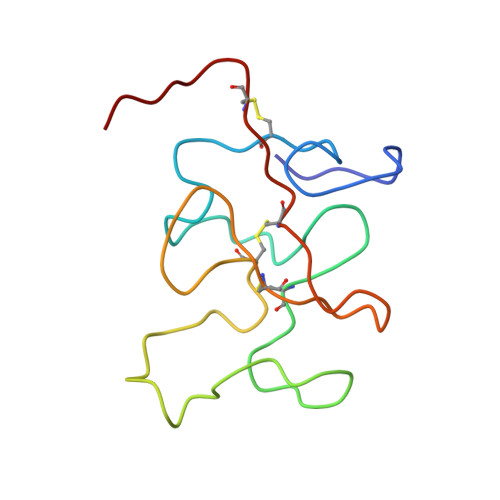Nuclear magnetic resonance (NMR) solution structure, dynamics, and binding properties of the kringle IV type 8 module of apolipoprotein(a).
Chitayat, S., Kanelis, V., Koschinsky, M.L., Smith, S.P.(2007) Biochemistry 46: 1732-1742
- PubMed: 17263558
- DOI: https://doi.org/10.1021/bi061814g
- Primary Citation of Related Structures:
2FEB - PubMed Abstract:
The plasma lipoprotein lipoprotein(a) [Lp(a)] comprises a low-density lipoprotein (LDL)-like particle covalently attached to the glycoprotein apolipoprotein(a) [apo(a)]. Apo(a) consists of multiple tandem repeating kringle modules, similar to plasminogen kringle IV (designated KIV1-KIV10), followed by modules homologous to the kringle V module and protease domain of plasminogen. The apo(a) KIV modules have been classified on the basis of their binding affinity for lysine and lysine analogues. The strong lysine-binding apo(a) KIV10 module mediates lysine-dependent interactions with fibrin and cell-surface receptors. Weak lysine-binding apo(a) KIV7 and KIV8 modules display a 2-3-fold difference in lysine affinity and play a direct role in the noncovalent step in Lp(a) assembly through binding to unique lysine-containing sequences in apolipoproteinB-100 (apoB-100). The present study describes the nuclear magnetic resonance solution structure of apo(a) KIV8 and its solution dynamics properties, the first for an apo(a) kringle module, and compares the effects of epsilon-aminocaproic acid (epsilon-ACA) binding on the backbone and side-chain conformation of KIV7 and KIV8 on a per residue basis. Apo(a) KIV8 adopts a well-ordered structure that shares the general tri-loop kringle topology with apo(a) KIV6, KIV7, and KIV10. Mapping of epsilon-ACA-induced chemical-shift changes on KIV7 and KIV8 indicate that the same residues are affected, despite a 2-3-fold difference in epsilon-ACA affinity. A unique loop conformation within KIV8, involving hydrophobic interactions with Tyr40, affects the positioning of Arg35 relative to the lysine-binding site (LBS). A difference in the orientation of the aromatic side chains comprising the hydrophobic center of the LBS in KIV8 decreases the size of the hydrophobic cleft compared to other apo(a) KIV modules. An exposed hydrophobic patch contiguous with the LBS in KIV8 and not conserved in other weak lysine-binding apo(a) kringle modules may modulate specificity for regions within apoB-100. An additional ligand recognition site comprises a structured arginine-glycine-aspartate motif at the N terminus of the KIV8 module, which may mediate Lp(a)/apo(a)-integrin interactions.
Organizational Affiliation:
Department of Biochemistry, Queen's University, Kingston, Ontario K7L 3N6, Canada.














